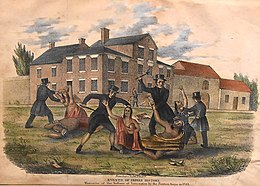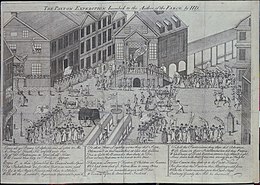Paxton Boys
The Paxton Boys were Ulster Scottish vigilantes who settled in and around Paxtang on the Susquehanna River in central Pennsylvania . The group was formed in 1763 to seek revenge on neighboring Indians after the Seven Years War and the Pontiac Uprising . The Paxton Boys are known mainly due to the Conestoga Massacre: two attacks on the last Susquehannock - Indians (Conestoga Indians) in Pennsylvania, during which a total of 21 people were brutally killed. An act that many contemporaries termed genocide. In January 1764, after the attack on the Conestoga, 250 Paxton Boys marched into Philadelphia to complain. In Germantown , they met with high-ranking people, including Samuel Peters and Benjamin Franklin . The Paxton Boys broke up after promising their cause would be taken before lawmakers.
founding
After the end of the Seven Years' War, the Pennsylvania border region remained troubled. A new wave of Ulster Scottish immigrants settled in increasing proximity to Indian areas. These settlers claimed that the Indians often attacked the settlements, killing men, women and children. Paxtang Presbyterian pastor, John Elder, began organizing a people's mounted army of settlers. Often called the “fighting clergyman,” because he always kept a rifle in his minister's desk, Elder was chosen to lead the group.
Attack on the Susquehannock

The Conestoga were the last of the Susquehannock tribe who had lived peacefully with their European neighbors for decades on a piece of land that William Penn had granted to their ancestors. The inhabitants of this settlement lived by bartering handicrafts, hunting and the food they received from the Pennsylvania administration. At dawn on December 14, 1763, more than fifty of the Paxton Boys attacked the Conestoga settlement near Conestoga Town (now Millersville) in Lancaster County . Most of the Indians were not in the settlement at the time; they had been unable to return home due to a snow storm and stayed with neighbors. The six people who could still be found in the settlement were mutilated, scalped and killed. A large part of the settlement was burned down. Governor John Penn condemned this act as murder and put a bounty on the perpetrators. The last sixteen Conestoga Indians were brought to safety in Lancaster prison by John Penn. On December 27, 1763, fifty to a hundred Paxton boys rode into Lancaster and stormed the workhouse where the Indians were staying. As they were entering the workhouse, an old, well-known Indian named Will Soc reportedly said, "I will go to you because you are my brothers" However, he was shot on the doorstep before the rest of the Conestoga, six adults and eight Children murdered and scalped and their bodies mutilated with tomahawks. The Pennsylvania administration raised the bounty to $ 600. However, the perpetrators were never identified.
Invasion of Philadelphia
In January 1764, 250 Paxton Boys began to march to Philadelphia , where 140 Christian Lenape Indians were still brought to safety on an island in the Delaware River . The Paxton Boys threatened to exterminate these "heathens" and all those who protected them. They accused the Quaker-dominated Pennsylvania administration of not being ready to protect the white Christian citizens from the barbaric Indians. The number of the Paxton Boys continued to grow during their slow march to the colony's largest city as German and English settlers joined them. The violent mob set up camp in Germantown on the Schuylkill River , which was then outside of Philadelphia. There they met John Penn's army, which consisted of around 500 volunteers. The Paxton Boys approached the militia barricades until the governor announced that any group of more than 12 "tumultuous and vicious men" would be sentenced to death. When the army got ready to fight, the mob was finally ready to talk. Key representatives of the Paxton Boys met with Benjamin Franklin and other influential Philadelphia politicians and promised to give in to the demands and to dissolve on the condition that they would take the Paxton Boys' complaints to the administration.
Reactions
Although the Conestoga lived peacefully next to their pacifist German neighbors , the Paxton Boys and other groups in Lancaster suspected them of providing information about the neighboring Iroquois and other tribes who fought the British in the Seven Years War and during the Pontiac Uprising Settlements delivered. Many in Lancaster supported the massacre and considered it necessary for the colony's safety to remove the Indians. Pastor John Elder wrote to the governor after the attack. In his letter, he stated that the administration was responsible for the attack and that the perpetrators were "virtuous and decent in private life, not cruel but gentle and compassionate". He went on to say that the tragedy would never have happened if the governor had removed the Indians, as has been requested several times. This statement was very popular. Others, especially the pacifist Quakers , Mennonites and Amish , were shocked by the brutality of the murder, saying that the deeds and behavior of the Paxton Boys were worse than the Indian attacks. John Penn called them "evil people" and Benjamin Franklin wrote that the peaceful Conestoga would have been safer among barbarians, with the Turks or in Africa than next to these "white, Christian savages".
Web links
- "A Narrative of the Late Massacres ..." , (en) Benjamin Franklin's account of the massacre and his criticism of the Paxton Boys.
Individual evidence
- ↑ Mathias Wilson McAlarney: History of the sesqui-centennial of Paxtang church: September 18, 1890 . Harrisburg Publishing Company, 1890, p. 224.
- ^ A b William Buell Sprague : Annals of the American Pulpit: Presbyterian. 1859 . Robert Carter & Brothers, 1858, pp. 77-79.
- ^ A b c John H. Brubaker : Massacre of the Conestogas: On the Trail of the Paxton Boys in Lancaster County. . History Press, 2010, pp. 23-24.
- ↑ Ben Kiernan: Blood and Soil: A World History of Genocide and Extermination from Sparta to Darfur. Yale University Press, 2007, pp. 724. ISBN 978-0-300-10098-3 , ISBN 978-0-300-10098-3
- ↑ Jeremy Engels: Equipped for Murder: The Paxton Boys and The Spirit of Killing All Indians in Pennsylvania, 1763-1764. Rhetoric & Public Affairs, Vol. 8, No. 3, 2005, pp. 355-382; ISSN 1094-8392
- ↑ Ben Kiernan: Blood and Soil: A World History of Genocide and Extermination from Sparta to Darfur. Yale University Press, 2007, pp. 724. ISBN 978-0-300-10098-3 , ISBN 978-0-300-10098-3
